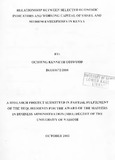| dc.contributor.author | Ochieng, Kenneth O | |
| dc.date.accessioned | 2013-03-19T07:26:30Z | |
| dc.date.issued | 2012 | |
| dc.identifier.citation | Masters in Business Administration | en |
| dc.identifier.uri | http://erepository.uonbi.ac.ke:8080/xmlui/handle/123456789/14566 | |
| dc.description.abstract | Small and Medium enterprises are acknowledged in Kenya as significant contributors to
economic growth. Despite this, it is estimated that up to 40% of the start-ups fail by year
2 and at least 60% close their doors by year 4. SMEs comprise the largest proportion of
businesses in most economies and frequently offer greatest potential for job creation and
promotion an enterprise culture. SMEs are believed to be an impetus to the economic
progress of developing countries and its importance is gaining widespread recognition.
However, given their reliance on short-term funds, it has been recognized that the
efficient management of working capital is crucial for the survival and growth of small
firms.
The objective of this study was to examine the relationship between selected economic
indicators and working capital of small and medium enterprises in Kenya. While recent
research supports the view that smaller firms tend to be more liquid than larger firms,
availability of short term funds throughout the economy is affected by economic
conditions prevailing at a particular point in time. A sample of 30 SMEs within Nairobi
area was used. The selected firms were studied over a period of five years from 2006 to
2010. The findings from this study showed that there is a positive relationship between
selected economic indicators and working capital for these firms during periods of
economic expansion. This shows that proper management and forecasting working
capital requirements in line with projected economic growth is a very important task of
finance managers and policy makers. The study corroborates other research findings such
as Lamberson (1995) that established a positive relationship between working capital of
small and medium enterprises and economic indicators.
From the research findings, it can be concluded that since working capital needs of
organizations change over time as does its internal cash generation rate, small firms
should ensure a good synchronization of its assets and liabilities as economic conditions
change in order to remain viable. | en |
| dc.description.sponsorship | The University of Nairobi | en |
| dc.language.iso | en | en |
| dc.publisher | University of Nairobi | |
| dc.subject | Small and Medium enterprises in Kenya | en |
| dc.subject | Economic Indicators | en |
| dc.title | Relationship Between Selected Economic Indicators and Working Capital of Small and Medium Enterprises in Kenya | en |
| dc.type | Thesis | en |
| local.publisher | School of Business | en |

